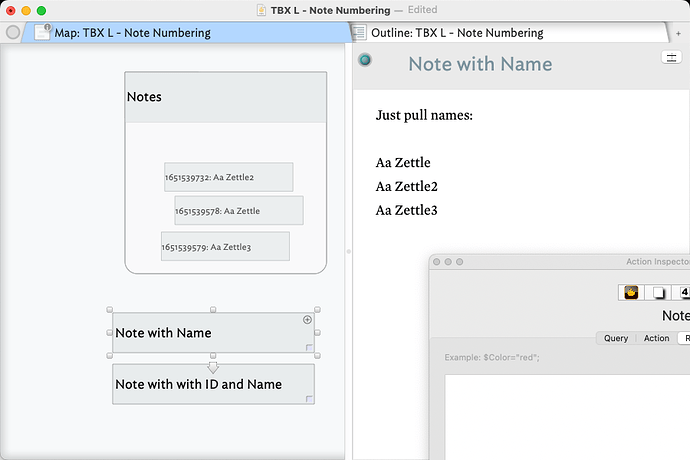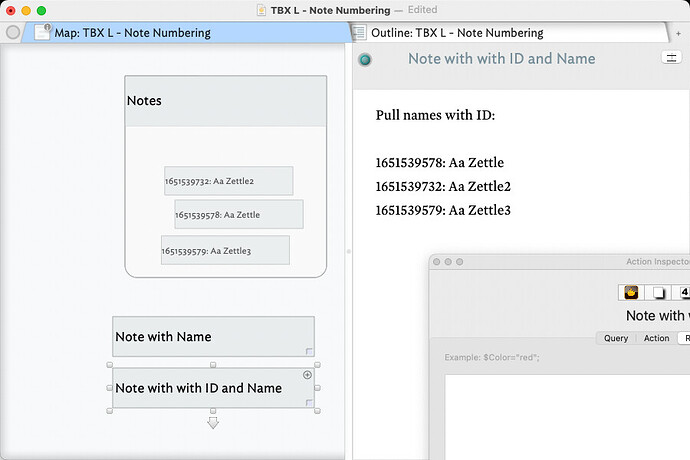Hi everyone! I’d like to use a Zettelkasten Id for a new project I’m working on and while I was searching for a way to renumber my index cards in the Luhmann’s style, reading this discussion – A Tinderbox solution to organising a Zettelkasten? –, I wondered how you adjust your Tinderbox file if you use yourself that method. More precisely: I found here, on this forum, some examples of Zettelkasten, but I’d like to understand the rules which would allow me to develop a strong numbering. What rule should I use? Thanks for your suggestions.
I suggest you to read about concept of Folgezettel in Luhmann’ ZK, here and here, is a good start ![]()
Arek
Hi Dominique. If you download the starter file, you’ll find I had a go at thinking about some of your questions. The threads on this forum around it that you’ve already pointed to you should also help you think through it, for and against.
Thanks for your answers.
@talazem: I like the way you number your zettels. How do you succeed in getting this Zettelnumber? I don’t see anything in the section of your fille called “Codes”.

Take a look at the note named ‘Configuring your zettelkasten for export’, where this is explained.
Thank you. There’s a lot of work behind that file and a simple note! I’m going to simplify my file and use a YYYYMMDDHHMM id I’m more familiar with.
The numbering is actually automatic, thanks to Mark A’s help! If using it as a wholly digital zettelkasten, the numbering is actually of little utility. It is primarily of use if exporting or printing the notes.
I didn’t see that Tinderbox does not break a link even if its name has been modified. That’s why I thought it was necessary to assign a number to a note. For the moment, this is how I number my notes (my file is in progress) :
But, is there any Tbx rule to automatize the process which would consist in giving a letter to a note in order to specifiy that note as a subsequent one? For instance:
-
202205020939a
-
202205020939b
… and so on ?
see the .next() operator.
Personally, I find the exercise of trying to map Lhuman’s process verbatim to TBX a quixotic exercise. I take the spirit of his method and then apply this spirit to the modern context. To this end, in my opinion, an extra index ID is not needed. You ready have a universally unique ID for every note, i.e., $ID. You can then use this in combination with action code and export code to do glorious things. So far this year I’ve written a draft 250-page book (due our in June/early July), 3 book chapters, 2 websites, organized a conference, and created over 1000 unique insights, “aka Zettles,” and more with this process in mind. All the notes are unique and discoverable. The secret for me is NOT the note $ID, although this is a foundational mechanic. The secret is in the automated not creation from attributes, linking, citing (aka curation) and use of action code and templates to create magic! There are a handful of other tools I bring into the mix to really spruce up my system.
Sidenote: beyond the $ID number simple being a reference number, there is value in using association attributes and links and distance from other notes. This can be used leveraging attributes.
You’re right. It’s not about mimic slavishly Luhmann’s method. However, in my own experience, the association between some numbers and a title speaks to me in a visual manner.
Perhaps because it reminds me some old habits: using paper cards with numbers: https://gallica.bnf.fr/ark:/12148/btv1b10000511d/f748
Would it be useful to use an $ID for every note? Could this $Id be a part of the name of each note?
It seems that I found what I was looking for: I number some of my notes that I need to memorize periodically: 01…02…03… and I use a time stamp to number my “fleeting notes”. It’s not totally rational, but it speaks to me. « What am I searching for? Oh yes, card number 158: “Objectité”. »

Thanks for your help!
Yes, could easily do this. I would NOT recommend polluting the actual $Name with the $ID, as you’ll need/want to use the $Name in export output. If you want a visual affordance you can use display expression. You’ll want to keep the attributes separate so that you can act on them separately in sort, export code and action code.
This is a silly example, but here you go. Note how you can visual see the numbers and names and then use code to action on them.
TBX L - Note Numbering.tbx (86.1 KB)
Thank you for taking time to suggest me those paths!
I’m not familiar with Action Code and I must admit that after all this time I’ve been using Tinderbox, I should know a little more about it. Upon reflection and remembering why I tend to use numbers to identify my notes, an old old scholar habit which consists in quoting very precisely a text — Aristote, Poétique, 4, 1448 b 4, or Wittgenstein, Tractatus Logico-Philosophicus, 6.54, for instance — I think in the end that I’m going to use Luhmann’s numbering for my notes on the fly and not an ID or a time stamp.
There’s a strong reason for that choice even if it has been discussed in this thread very precisely: https://forum.eastgate.com/t/a-tinderbox-solution-to-organising-a-zettelkasten/3073/5. I organize my “fleeting notes” as an ordered outline.
It is notable that the structural implications of the numbering system in the Tractatus turned out to be ambiguous and was probably misunderstood until recently (if Bazocchi’s recent interpretation is correct).
Evidently, it is sometimes hard to know whether one has climbed a ladder.





